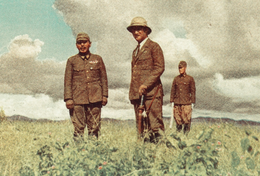Hisaichi Terauchi
This article needs additional citations for verification. (March 2020) |
Kotaro Nakamura | |
|---|---|
| Personal details | |
| Born | 8 August 1879 Northern China Area Army Southern Expeditionary Army Group |
| Battles/wars | Russo-Japanese War |
| Awards | Order of the Rising Sun (1st class) Order of the Golden Kite (1st Class) |
Count Hisaichi Terauchi (寺内 寿一, Terauchi Hisaichi, 8 August 1879 – 12 June 1946) was a Gensui (or field marshal) in the Imperial Japanese Army, commander of the Southern Expeditionary Army Group during World War II.
Biography
Early military career
Terauchi was born in
After the war, Terauchi returned to the
In early November 1919, he succeeded in the hereditary title of hakushaku (count) under the kazoku peerage system upon the death of his father, and was raised in military rank to colonel. In September 1920, he became commander of the 3rd Guards Infantry Battalion, and chief-of-staff of the Imperial Guard from September 1923.
As general
Terauchi was promoted to major general in February 1924 and was assigned to the staff of the IJA 1st Division in March 1926. In September 1926, the San'yō Main Line train he was riding on derailed in an accident that killed 34 people, but Terauchi was not injured.
In August 1927, Terauchi became
In August 1934, Terauchi was transferred to command the
Military-political career

After the
World War II
In February 1937, Terauchi was appointed head of the

In November 1941, Terauchi was transferred to command of the
As the war in the Pacific drew to a close, a British Intelligence Liaison Officer, Major Richard Holbrook McGregor, was sent by
The 2nd Count Terauchi surrendered his family heirloom

War crimes
Terauchi was given command of Southern Expeditionary Army, responsible for the opening Japanese offensive of the Pacific War. He was critical of Masaharu Homma for being too "soft" on Filipinos and of Hitoshi Imamura for granting too much power to the Indonesian puppet government.[8] Terauchi's attitude likely played a role in Homma's subsequent relief and retirement.
Terauchi thought the army should stay out of politics, by which he probably meant that the politicians should keep their hands off the army. In other respects he was a typically ruthless Japanese Army officer. Neither the Americans nor his own peers thought much of him, but his staff were impressed by the fact that such a wealthy man chose to live so frugally. Yamashita felt otherwise, writing in his diary that "... that damn Terauchi lives in luxury in Saigon, sleeps in a comfortable bed, eats good food and plays shogi".[9][10] Yamashita added that:
If there are two ways of doing something, trust Southern Army to pick the wrong one.
When told that Terauchi was in too poor health to attend the surrender ceremony at Singapore, Mountbatten sent his own doctor to examine Terauchi. The doctor confirmed his fragile health, and Mountbatten had him transferred to a bungalow in Malaya in March 1946. On 11 June 1946, Terauchi became angered by a report of a Kempeitai lieutenant colonel who had threatened to disclose Japanese war crimes to the Allies, and he suffered a second massive stroke and died early the next morning. As a consequence, he never stood trial for war crimes, such as his responsibility for mistreatment of laborers on the Burma-Siam Railroad and his order that all Allied prisoners of war in his command area were to be massacred if Japan was invaded.[11]
Notes
- ^ Ammenthorp 2000.
- ^ a b Tobe 1998, p. 248.
- ^ Aldous 1997.
- ^ Large 1992.
- ^ Fuller 1992.
- ^ Budge 2015.
- ^ Hollingworth 2006.
- ^ Boatner 1996.
- ^ Drea 2009.
- ^ Toland 1970.
- ^ Hayashi 1959.
References
- Aldous, Christopher (1997), Police in Occupation Japan, CRC Press, p. 41, ISBN 978-0-203-44014-8, retrieved 22 July 2009
- Ammenthorp, Steen (2000). "Terauchi, Hisaichi". The Generals of World War II.
- Boatner, Mark Mayo (1996). Biographical dictionary of World War II. Novato, CA. ISBN 0-89141-548-3.)
{{cite book}}: CS1 maint: location missing publisher (link - Budge, Kent (2015). "Terauchi, Hisaichi". Pacific War Online Encyclopedia.
- Drea, Edward J. (2009). Japan's Imperial Army : its rise and fall, 1853-1945. Lawrence, Kan.: University Press of Kansas. ISBN 978-0-7006-1663-3.
- Fuller, Richard (1992). Shokan: Hirohito's Samurai. London: Arms and Armor. ISBN 1-85409-151-4.
- Harries, Meirion (1991). Soldiers of the sun : the rise and fall of the Imperial Japanese Army, 1868-1945. London: Heinemann. ISBN 9780434313525.
- Hayashi, Saburo (1959). Kogun: The Japanese Army in the Pacific War. Translated by Cox, Alvin D. Quantico, VA: The Marine Corps Association. ASIN B000ID3YRK.
- Hollingworth, Will (24 January 2006). "Queen nixed mum's surrender sword slight: book". The Japan Times.
- Tobe, Ryōichi (1998), 日本の近代 (in Japanese), vol. 9, Tokyo: Chūōkōron-sha, ISBN 978-4-12-490109-2
- Toland, John (1970). The Rising sun : the decline and fall of the Japanese Empire, 1936-1945. Toronto: Bantam. ISBN 0-553-20462-9.
- Large, Stephen (22 October 1992). Emperor Hirohito and Showa Japan: A Political Biography. London: Routledge. ISBN 0-415-03203-2.
See also
- Dupuy, Trevor N. (1992). ISBN 0-7858-0437-4.
- Fukagawa, Hideki (1981). (陸海軍将官人事総覧 (陸軍篇)) Army and Navy General Personnel Directory (Army). Tokyo: Fuyo Shobo. ISBN 4829500026.
- Hata, Ikuhiko (2005). (日本陸海軍総合事典) Japanese Army and Navy General Encyclopedia. Tokyo: St. Martin's Press. ISBN 4130301357.
